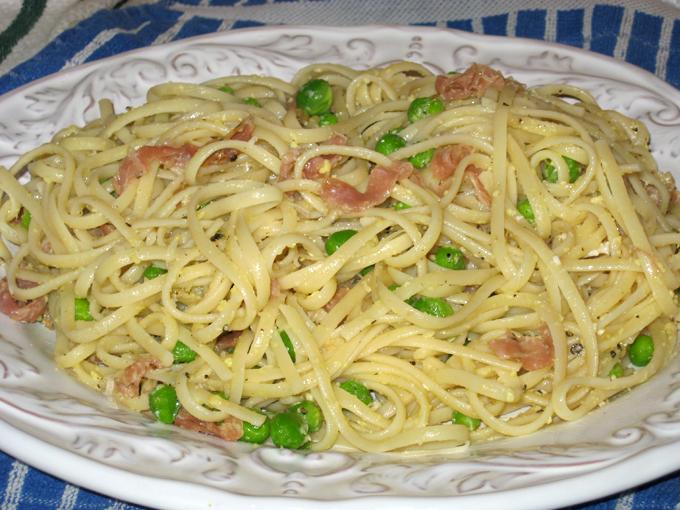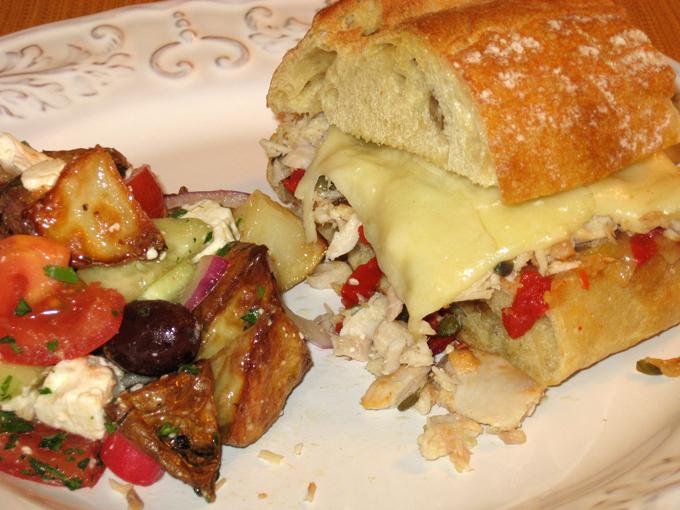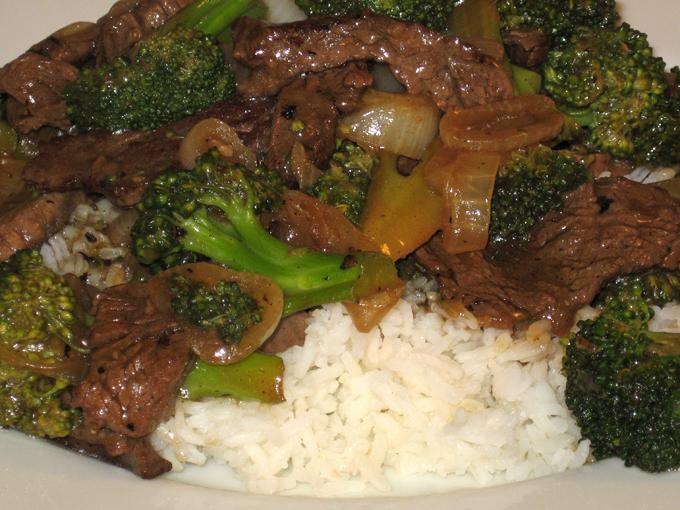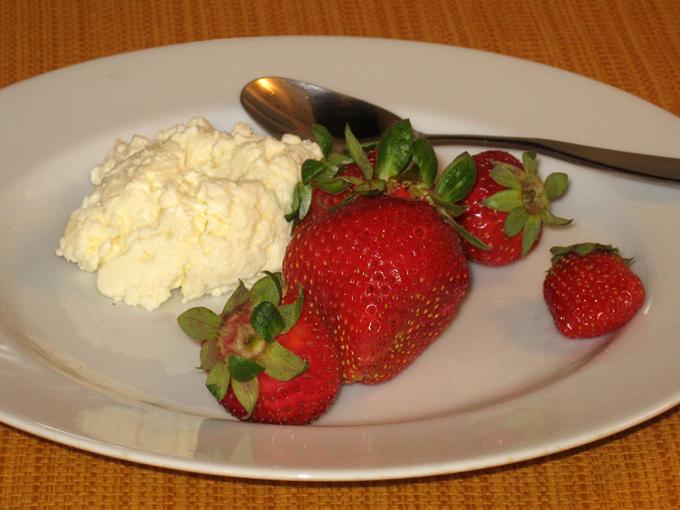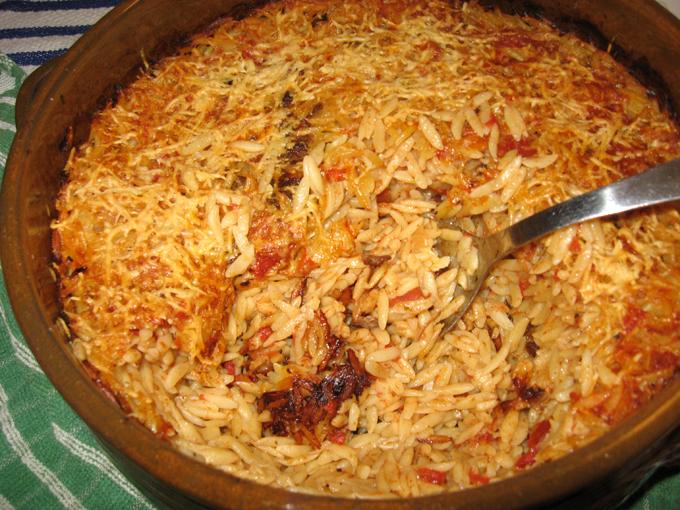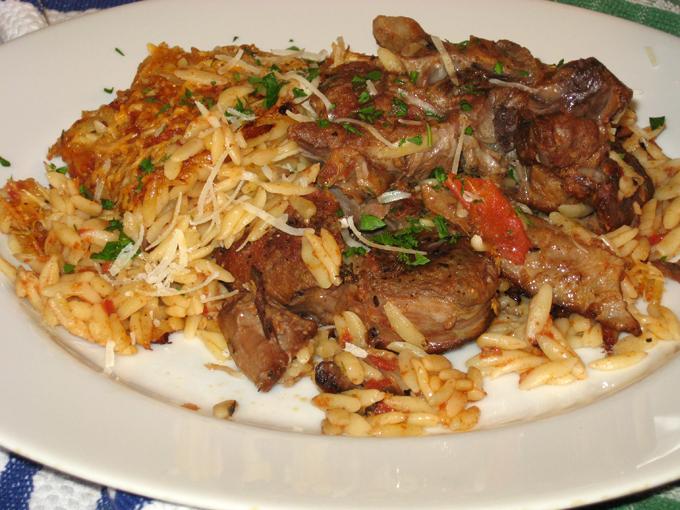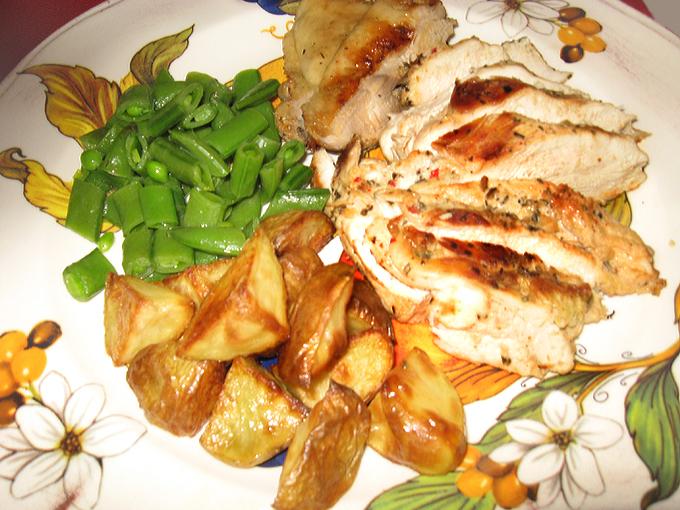-
Posts
1,729 -
Joined
-
Last visited
Content Type
Profiles
Forums
Store
Help Articles
Everything posted by djyee100
-
Kim, that Bibb lettuce, prosciutto & egg salad looks so good! Tonight's dinner was late, I was hungry, and I must have assembled the fastest Pasta alla Carbonara of my life, this time with fresh spring peas (already shelled) and San Daniele prosciutto. I discovered this pasta tastes better the faster you make it. For this dish, I tossed together in the warm pasta cooking pot: hot cooked linguine (1/2 lb uncooked), 2+ cups hot cooked peas, 1/4 lb julienned prosciutto, 2 TB butter (or more--I kept adding to taste), 3/4 cup grated parmigiano reggiano cheese, 2 eggs beaten, and plenty of freshly ground black pepper. It's done when the eggs form little curds on the strands of pasta.
-
It depends on how the pig's feet are prepared. They can be obnoxious if they are all bland fat and pork skin. Also, pork skin is not something that is to everyone's taste. Hard to tell from your pic, but I've been told that the (smaller) front pig's feet are better eating than the (bigger) back pig's feet. In Thailand we ate braised/roasted pig's feet that had been deboned and stuffed with sausage and salted preserved duck egg. It was served in a ginger, garlic, soy, star anise, and cinnamon sauce. Those pig's feet were not layered in fat. Mostly the pork skin, which was nicely browned, served as a wrapping for the filling. The whole dish tasted very good. Where I live, pig's feet are readily available in Hispanic and Asian markets. ETA: I just remembered that we ate those pig's feet in a Yunnan Chinese community living in Thailand. So really, the dish was of Chinese origin, not Thai.
-
That's a gorgeous grilled steak, Robirdstx. A summer-y dinner here of sandwiches and salad. The sandwich was a Tuna Grinder of tuna confit (fresh tuna cubes slow-poached in olive oil with garlic, herbs, and spices), caramelized onions, capers, roasted piquillo peppers, and gruyere cheese. After splitting an Italian loaf lengthwise, I layered on the ingredients, wrapped the loaf in aluminum foil, and heated it in the oven until the cheese melted and the bread turned a little crispy. I hadn't tried this combination of ingredients before, and it tasted good! The salad was a Roasted Potato Salad that I learned to make from a friend. She once brought it to a potluck dinner and it was the hit of the party. It's basically a Greek salad that substitutes roasted potatoes for the lettuce--a nice touch for people who like hearty salads. To make this salad, combine roasted potato chunks, tomatoes, cukes, radishes, red onion, kalamata olives, feta cheese, and freshly chopped parsley. Toss with a garlic & red wine vinaigrette that has a pinch of dried oregano added to it.
-
That meal looks delicious, Deadstroke. Kim, how was the lemon balm with that great smoked chicken? For dinner here, time to clear some space in an overstuffed refrigerator. Between this week's CSA box and an impromptu trip to the market, various fruits and veggies were falling on the floor when I opened the fridge. Green garlic, fresh spring onions, a head of broccoli, plus some skirt steak from the freezer, turned into a simple Asian stirfry of Beef with Broccoli in a ginger-soy sauce. Followed by a delicious if non-Asian dessert of Ricotta with Strawberries. A very rich ricotta from Bellwether Farms (made with the milk of their jersey cows), and the last strawberries from this week's CSA box. I've tried this ricotta only recently, but I'm already seriously addicted to it.
-
I owned this one for a long time & liked it. Sometimes, though, the cookbook was too thick to fit comfortably in the holder. Somehow I managed to scratch up the acrylic, too. http://www.amazon.com/Norpro-737-Acrylic-Cookbook-Holder/dp/B0002ZFXOQ/ref=sr_1_1?ie=UTF8&s=home-garden&qid=1274936126&sr=8-1 So I discarded the acrylic holder, & I bought one like this, adjustable for thick cookbooks. It has sat in my closet for years. It's heavier and more clumsy than the acrylic one, you have to adjust the cookbook before you start, dadadadada...apparently that's enough effort for me to just say Forget It. (I'm scratching my head as I write this. How lazy can you get?) http://www.cooking.com/products/shprodde.asp?SKU=136856 Then my mother, who doesn't cook or read books, surprised me with a gift of a book weight, which turned out to be perfect. I dump the weight on the page I want in the cookbook, and the book stays open on the counter. No fuss. The only drawback, the page might get splashed if it's too near the cooking action, though I haven't had that problem. If I want to write notes in my cookbook, which often happens, I just pick up my pen & go at it, no moving around acrylic things. How my mother ever found the right cookbook holding tool for me still boggles my mind, since this is someone who keeps personal belongings in her pristine, unused oven. The last time I visited, when I wanted to cook something, I couldn't find her measuring cups. She told me she had used them to hold paintbrushes when she did some paint touchup in her apt, then she threw them away. I mean really...! http://www.amazon.com/PhotoFramesPlus-Tan-Leather-Book-Weight/dp/B000Y4WWZ8/ref=sr_1_1?ie=UTF8&s=home-garden&qid=1274937249&sr=1-1
-
I'm jealous. I've never tried mulberries, maybe seen them once or twice in a farmers mkt around here. I'll have to keep an eye open for them again. In her Fruit cookbook, Alice Waters suggests making ice cream, sorbet or a summer fruit soup with mulberries. Her recipes instruct people to puree the berries in a food processor, then push the puree through a sieve. I guess that process takes care of the central stem & any seeds. Pls let us know how your mulberry cooking goes! ETA: Waters also says the berries last a day or two in fridge. She says the berries freeze well.
-

Hummus: Additives, Techniques, Recipes
djyee100 replied to a topic in Middle East & Africa: Cooking & Baking
I was told by a chef with strong opinions that the blades of the blender are faster than a food processor's. That's why he made all his herbal oils, e.g., basil oil, in the blender. He said the faster blades retained the fresh green color of basil. In a food processor, the basil tended to oxidize. I've found that to be true, at least with basil oil, in my blender and food processor. I've also found that bread crumbs, made from toasted bread, pulverize finer in a blender. Can't say I've done an immense amt of research on blenders vs food processors in general (nor do I intend to). I make hummus in the food processor myself. But then, I like a slightly chunky texture. -
For dinner tonight, my idea of comfort food, Greek Lamb Yiouvetsi with Pasta, Tomatoes, and Cheese. Lamb shoulder chops braised in tomato sauce with Aleppo pepper and cinnamon, combined with orzo pasta, then slow-baked so the flavors meld. A little before the end of baking time, some pecorino romano cheese is sprinkled on top. The casserole comes out of the oven with a crispy cheese crust. Garnished with more grated pecorino cheese and fresh parsley, and served warm, rather than hot. A homey dish, yet with complex flavors. The long cooking time makes the difference. My variation of a recipe from Paula Wolfert's Mediterranean Clay Pot Cooking. I split some lamb shoulder chops, keeping the bone in for more flavor, and seared the chops in a skillet before braising. Other than that, I followed the recipe. It's available on Googlebooks, Page 136. http://books.google.com/books?id=DwtbDDGaQcIC&pg=PA136&lpg=PA136&dq=wolfert+greek+lamb+yiouvetsi+pasta+tomatoes+cheese&source=bl&ots=qlxLQC0_pR&sig=QNXUHcEerWAZhloEf09acJFX7ew&hl=en&ei=e2L3S7a8FYuyMtimmL8I&sa=X&oi=book_result&ct=result&resnum=1&ved=0CBQQ6AEwAA#v=onepage&q&f=false
-
For ideas on prep and planning, you can look at Carole Latimer's Wilderness Cuisine, if you haven't already. Carole's a longtime friend. I've gone on many, many trips where she was the guide & the cook for groups of people. (She's now retired.) A chunk of material from the book is available for reading on Googlebooks. http://books.google.com/books?id=uu1dw0FZDTsC&printsec=frontcover&dq=wilderness+cuisine&cd=1#v=onepage&q&f=false One of Carole's tips that people love: for the first day dinner, store lettuce in a plastic garbage bag. When it comes time to serve, pour in the dressing, smoosh and toss around the greens in the garbage bag, then serve. Clean-up means throw away the garbage bag. People can have lots of salad, and there's no salad bowl to wash. Another go-to dish, which Carole served on almost every trip, was pesto with spaghetti. The pesto can be made entirely ahead of time. You only cook the pasta in camp, and mix the hot pasta with the pesto in the cooking pot. The recipe is here, along with some of Carole's other recipes. http://www.callwild.com/page.php?id=6&cat=6 A couple years ago I tried the tamal zacahuil, a giant tamale that sometimes feeds a whole village on a feast day. In the version I tried (a puny tamal compared to some of the traditional ones), the cook laid out a large piece of heavy-duty foil on a table, then placed a couple overlapping banana leaves on the foil. Then he put on masa and filling (just like you would make a tamale), a couple more banana leaves, and another layer of foil. Then he wrapped up the whole thing into a secure bundle and grilled it for 1-1 1/2 hours, or however long it took for the masa to dry out to a firm but moist texture. Periodically the cook loosened the wrapping, just enough to poke a spoon or fork inside, to taste and check for doneness. To serve, he just put the tamal on a table, unwrapped it, and let people serve themselves from the giant, showy tamal. People really liked it. Anyway, I throw out this idea--maybe you could make a couple tamals of masa, roasted chiles, cheese and salsa to feed your party.
-
A clip-on digital thermometer shd be fine. Make sure the max temp of the thermometer is at least 400F. The probes shaped like an open hook tend to slip into the pot, taking the cable with them. For awhile I played around with a digital probe thermometer (the open hook design) to test the temp of liquids in a saucepan. The probe hung off the side of the pan while I was cooking. I always seemed to be adjusting the probe so that its tip (where it measures temp) stayed in the liquid, and didn't rest on the bottom of the pan. Eventually I went back to using my old clip-on Taylor thermometer.
-
I agree with others about using a candy/frying thermometer for deep frying. I have a Taylor candy/frying thermometer, which has a clip on the back that attaches to the side of the pan. It's supposed to stay in the oil during the entire frying time. Clipping it to the side of the pan keeps it out of your way. I'm assuming your recipe says to bring the temp to 350 degrees before you start frying. That sets a certain range of temperature within which (hopefully) you will be cooking your potatoes properly. Ideally, you should be cooking your potatoes around 350 at all times. But since adding food to oil drops the temperature, you have to learn to deal with that. Also, keep in mind that the time of 6 minutes is only a guideline. The potatoes are done cooking when they are done cooking! My advice is, don't mess with the stove controls in order to regulate heat. You will probably overshoot or undershoot your desired temperature, to your extreme frustration. Instead, once the oil hits your target temperature, learn to regulate the temperature by the amt of food you are cooking at any given time. This is how I deep-fry: - Heat the oil slowly over medium heat until it reaches the target temperature. The heating process may take 15 mins or more. Don't change the stove controls from medium heat. By this method, your oil is always at its peak temperature. - Put in smallish batches of food (about a handful) to cook at any given time. That way the temperature of the oil won't drop so much. Watch how the food is cooking. It should bubble and sizzle, and gradually brown. If it's browning too fast, the surface of the food will be cooked, but the middle will be underdone. Add some more food to slow down the cooking process. If the oil is getting too hot, quick, add more food to drop the temperature. But if the food seems to take too long to brown, add less food in your next batch so the temperature doesn't drop so much. You don't want to cook at too low a temperature, since the food will then absorb more oil. I realize all this sounds vague, but one learns by experience how to deep fry. Remember, you're learning to cook, not how to watch a thermometer. - I remove cooked food from the oil with a slotted spoon. As the pieces of food are done, I drain them on a rack that has been set over a paper towel-lined pan. I use a big cooling rack set over a half sheet pan. If you crowd the hot food, or pile the pieces on top of each other, they will steam and soften, and not be crispy. I don't drain fried food directly on paper towels, because the food can steam and soften that way. - Between batches, use a skimmer to take out the little brown and black bits in the oil that will cause the oil to smoke. If necessary, wait for the oil to heat up and regain your target temperature--again, without changing the stove controls from medium heat. - If you're frying a lot, there may come a time when your oil doesn't seem to brown as fast, and actually seems slow. You need to add some fresh oil to the pan, and let it heat up. - Smaller pieces of anything are easier to deep fry rather than large pieces, so if you are new to deep-frying, keep that in mind. - When you're deep frying, make sure any pets and small children are out of the way and not underfoot, preferably clear of the kitchen. - If your pan seems hard to clean of oil residue, use a heavy duty cleaner like Formula 409, which is supposed to take the grease off stovetops and ovens. good luck, & have fun (that's really the point of cooking, besides eating)
-
I don't know what to say about a vegetable that I like only when it's seriously fried, either in those dim sum cakes or thinly sliced as chips. On her website Kasma gives a simple recipe for fritters that sound good. Next to last paragraph: http://www.thaifoodandtravel.com/features/taro.html
-
Some nice produce there. As for the lemon balm, I've never done much with it myself, but these are some suggestions off the top of my head--You could add a little to a salad for a tangy lemon flavor, or stuff some sprigs into the cavity of a chicken before you roast it. You could also steep some lemon balm with fresh mint leaves for a tea. I've served cold herb tea in the summer (usually a mint tea with some sugar added to it), & people liked it.
-
Some info about the anaerobic fermentation scene on the "left" coast... My friend who is interested in anaerobic fermentation showed me this article soon after it came out. It took me awhile to track it down. I've tasted some of these pickles at the farmers mkt and they are good. http://www.ediblecommunities.com/eastbay/pages/articles/fallWinter08/theFermenteria.pdf
-
Questions like this are insidious. Late in the afternoon, they are so much more interesting to think about and research than the other work I'm supposed to be doing on my computer... There's a popular Chinese restaurant dish of deep-fried shrimp with caramelized walnuts. But except for that, no other savory caramel dish comes to my mind, outside Vietnamese cuisine. While checking out a couple of Andrea Nguyen's caramel recipes, which I remember from her cookbook Into the Vietnamese Kitchen, I came across this interview with her on a blog. She explains the origin of caramel sauce in Vietnamese (and she says all Asian) cooking. Towards the bottom of the page, caramel sauce: http://www.spicelines.com/2008/05/andrea_nguyen_talks_vietnamese.htm A couple caramel-y recipes I've tried from Into the Vietnamese Kitchen, and liked. - Chicken and Ginger Simmered in Caramel Sauce. For awhile, this was my go-to dish for weekday nights. It's delicious, and very quick and easy to cook--as long as you make the caramel sauce ahead of time. I kept a jar of caramel sauce handy in the cupboard. Recipe on this blog (same ingredients, different instructions). I suggest you skip Step 1 here and make the sauce as described on Andrea's website. http://www.seasonednoob.com/vietnamese-ginger-pork-with-caramel-sauce/ - Caramelized Minced Pork, which tastes like candied pork, if you can imagine such a thing. Available on this blog (a doubled recipe of the same ingredients, different instructions): http://www.braisd.com/whats-for-dinner-vietnamese-caramelized-pork Andrea's recipe for caramel sauce is on her website. It really is a burnt caramel sauce, dark as coffee or molasses with a reddish cast to the color, and quite bitter with a sweet taste underneath. http://www.vietworldkitchen.com/blog/2007/10/caramel-sauce.html Kim, perhaps your father would be more willing to try a Vietnamese caramel dish with chicken or pork.
-
Kathleen, thanks for taking the time to write your informative post. I've only done the aerobic kind of fermentation, making pickles as I was taught by a friend, and I've never made the anaerobic fermented pickles that you describe. In fact, before you chimed in, I knew zilch about anaerobic fermentation. One of my friends has become interested in anaerobic fermentation. I'll send him the link to your site.
-
For a home baking cookbook, I suggest: Baking From My Home To Yours by Dorie Greenspan. I've only cooked a handful of recipes from this book, but so far I've found the recipes to be very well-written, and even more important, well-tested. I like everything I've tried. This book is popular with other EGulleters and there's a big thread about it here: This book is sizable, so it's probably not a candidate for you to cook through. I mention it as a baking book you could look at.
-
Nickrey, I like your suggestion for keeping pickles under the brine. I make half-sour cucumber pickles every summer when I can, and I only use 2 liter sturdy glass jars with rubber gaskets, like these: http://www.amazon.com/Parfait-French-Glass-Canning-Gasket/dp/B001A5SF10/ref=pd_sim_k_1 I don't get it about the Pickl-It system. It seems to so complicated. Fermentation is a simple, naturally occurring process. Pack the vegs in brine, let the jar sit at room temp until the pickles are as sour as you like, then refrigerate or heat-seal for longterm storage. The containers should be nonreactive, but beyond that, they don't have to be anything fancy. The Pickl-It website says that its equipment "locks out oxygen." I hope they don't mean anything like a vacuum seal. If anything, the equipment should not be airtight during fermentation, if for no other reason that the fermentation builds up pressure in the jar. If they do mean a vacuum seal, that could spell trouble, as in botulism (!), for any low-acid canning environments that are not heat-treated for longterm preservation. The website gives green beans and garlic as examples of pickles to make. Yikes! I hope somewhere down the line people are instructed to vacuum seal those jars with a pressure canner.
-

Southwest - how conservative?
djyee100 replied to a topic in Southwest & Western States: Cooking & Baking
As a way to choose among your menu options, you could consider what ingredients are most readily available in Phoenix, and what produce will be in season when your son takes to the kitchen. That strategy will keep the costs down and make an easier start to the meal, just with the shopping. Eggplant is a great choice for the summer. Summer squashes, green beans, cucumbers, corn, peppers, and tomatoes all peak in the summer too. And remember those summer fruits, all the stone fruits (peaches, plums, nectarines) in early to mid-summer, then melons in late summer. -
Abebooks, the used booksellers consortium, also has Classic Italian Cook Book at various prices. http://www.abebooks.com/servlet/SearchResults?an=marcella+hazan&sts=t&tn=Classic+Italian+Cook+Book&x=81&y=13 FYI, book condition terms (always hard to find on their website) are given here: http://www.abebooks.com/docs/HelpCentral/Glossary/sellerIndex.shtml My two cents...I've cooked out of both Classic Italian Cook Book and Marcella's Italian Kitchen, and I like the food and the writing in Italian Kitchen better.
-
One of my absolutely favorite cuts of meat for Asian stirfries. I'll have to check my local WF. You could make the Thai classic Basil Chicken with those boneless thighs, cut up into bite-size chunks. I like this recipe, but if you're not used to very spicy food, go easy on the garlic and chiles. http://www.thaifoodandtravel.com/recipes/baschi.html You could also make an Indian or Thai chicken curry.
-
I like the taste of onion and garlic, lots of it depending on what's cooking, so any effort towards subtlety would be lost on me. Consider also what makes something taste good--not necessarily an intensity of some flavors, but how all the flavors balance or enhance each other. So a brazenly garlicky oniony dish with matching strong flavors could be very good (and usually is, in spaghetti sauce). I would use the oil-infusing technique you describe if the onion or garlic was in danger of burning with prolonged high heat, then turning bitter. Most people don't like that flavor, myself included. Otherwise the technique might be useful to control texture, e.g., attain a very smooth texture in a sauce. You could also grate onion or press garlic with the same result. Chill the onion first, then grate it against the medium-shredder side of a box grater. It goes quickly, TG, as long as you don't have a lot to do. Chilling the onion will lessen the volatile compounds that cause the tears.
-
I've been tempted to cook through Alice Waters' The Art of Simple Food myself. It's the only cookbook where I've considered doing that, too. The cookbook is like a primer for the Chez Panisse style. Not only that business about fresh local seasonal organic, blah, blah--the recipes are examples of great home cooking, very do-able and cook-able, and some of the recipes are quick too. I've cooked over 30 recipes from this book, and I've recommended it to others. Some of the recipes in the book are the best I've ever tasted for that particular dish. The technique is sound, and sometimes innovative and more efficient compared to classic methods. Waters has her own way of doing things. As with all of Alice Waters' recipes, you must have access to great ingredients, especially great produce, and you must be willing to spend money on food. Her recipes emphasize natural flavors, so you have to start with a baseline of flavorful ingredients. I've also cooked a great deal out of Judy Rodgers' Zuni Cafe Cookbook, which has tasty recipes and great explanation of her technique. Another favorite has been Annie Somerville's Everyday Greens, if you ever want to explore exemplary vegetarian cooking.
-
Wonderful meals, everyone. Deensiebat, I love asparagus pizza, & I try to make it at least once a year as a rite of spring. I haven't gotten to it yet this year, though. Tonight's dinner, Fried Spatchcocked Chicken, from Paula Wolfert's Mediterranean Clay Pot Cooking, aka Chicken Cooked Under A Brick. The chicken is marinated with olive oil, garlic, lemon juice, fresh rosemary, and crushed red pepper, then grilled under a clay weight. The marinade makes for a delicious chicken. I deboned my chicken for more even cooking and easier eating. The recipe is available on Googlebooks, page 86: http://books.google.com/books?id=DwtbDDGaQcIC&printsec=frontcover&dq=mediterranean+clay+pot+cooking&cd=1#v=onepage&q&f=false Served with roasted potatoes and sauteed sugar snap peas. I received the sugar snap peas from my CSA, and flipped through Alice Waters' Chez Panisse Vegetables to figure out what to do with them. A simple recipe, but really, one of the best ways I've found to cook sugar snap peas. They tasted sublime. This is my adaptation of the recipe. Sauteed Sugar Snap Peas: Trim the sugar snap peas, and slice into 1/2-inch pieces. Put them into a skillet so that they form a shallow layer, and add 1/4-inch water, a pat of butter, and a dash of salt. Bring to a boil and cook over medium-high heat for about 3 mins until the liquid evaporates and the snap peas are tender crisp. Taste for seasoning, and serve. BTW, the recipe for Roasted Chicken with Moroccan Flavors, also from Mediterranean Clay Pot Cooking, is now available on Googlebooks at page 85. I don't think it was before, when I cooked the recipe upthread. Googlebooks seems to be rotating the recipes it shows from this book. The Moroccan-style roast chicken was fantastic, so if you want the recipe, find a pen and paper and take some notes while the recipe is still on view.
-
Oho. You need a convenient dish to accommodate commuting. I'm a little disappointed. I would prefer that you're about to throw a fabulous dinner party for multitudes. Along the same lines as the chicken marbella, I like Chicken with Figs and Apricots from the Silver Palate cookbook. The recipe is here: http://www.epicurious.com/recipes/member/views/CHICKEN-WITH-FIGS-SILVER-PALATE-1234269 You could serve it with polenta, which you can cook ahead of time and which will stay warm on the stovetop for an hour. I cook Judy Rodgers' version in her Zuni Cafe cookbook. It's similar to David Tanis's recipe, available here & buried in the middle of the blog entry. http://shadowcook.com/tag/polenta/ Has anyone mentioned slow-cooked pork butt? One of my faves, a six-hour pork roast from the Mimosa restaurant in LA. I discovered the recipe one day while procrastinating on my work and surfing on the web. http://www.epicurious.com/recipes/food/views/Six-Hour-Pork-Roast-102530 I also like Shirley Corriher's recipe for slow-cooked pork, which she has sometimes called Luau Pork. I prefer adding more rather than less of worcestershire sauce, 1/3 cup. This adapted recipe says you can't open the oven door, but I do. I also cook the pork roast for about 6 hrs. If you can get the rice cooker going, and make some pineapple salsa ahead of time, you'll have a tasty dinner. http://www.ochef.com/r49.htm


